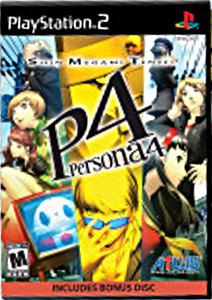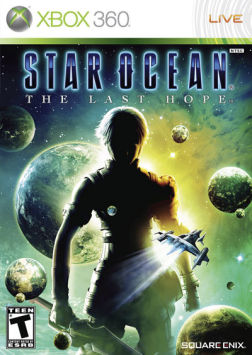[Break Time! is a series of posts about video games that Rick has spent entirely too much time with over the years.]
Introduction
The Playstation 3 and Xbox 360 have both been out for some time now, but did you know there was still good gaming to be had on the relatively ancient Playstation 2? Just this past December, the Playstation 2 got what might be its last great game: Shin Megami Tensei: Persona 4.

Persona 4, for the Playstation 2
The Shin Megami Tensei (“MegaTen”) games, brought to us by Atlus, are for the most part turn-based role-playing games that feature themes that are darker and more adult-oriented than the typical Japanese role-playing game that’s brought over to the USA. The Persona series is something of a spinoff series, featuring some of the same gameplay elements as the main line of games, but with more emphasis on character interaction than the others.
Like its predecessor, Persona 4 takes place in a Japanese high school (a somewhat ironic setting given that in the USA the game is rated “M”). You take on the role of “the protagonist” – a character who you name and control throughout the game. You start off your new life as a big-city boy who goes to live for a year with his uncle in the quiet town of Inaba. Quiet, that is, until two things happen:
- Dead bodies start turning up hanging upside down from TV antennas, and …
- You discover that you’re able to jump into television screens.
Inside the television, you discover you have a power to summon and breed your own monsters (the “persona”s in the game’s title). Using these monsters, you do battle with other monsters inside the television, hoping to both prevent more people from showing up dead and discover just what the heck is going on with this weird world inside the television.
Graphics and sound
For a Playstation 2 game, the graphics are done quite well. Environments look like what they’re supposed to represent, and dungeons are sufficiently colorful and weird. Some of the models for the Personas are qutie bland, but since they are not onscreen very often, it’s not a big deal.
If you’re a veteran to the Persona series, you will also notice that quite a few of the monsters and personas were simply lifted from Persona 3.
The game’s sound effects are servicable. Things sound, more or less, like they’re supposed to. The background music is primarily Japanese pop songs with English (or should I say “Engrish”) lyrics. A typical example of the Engrish lyrics, from the song that plays when you’re inside your uncle’s house: “Signs of love overshadowed by dreams / baby, don’t worry ’cause you ain’t alone / only time running days without nights / tears pass through“. Say what?
The music is appropriate for a game set at a high school, and (either fortunately or unfortunately) some of the songs will get stuck in your head. In case you don’t get enough of the music in the game itself, the game comes with a soundtrack CD which contains some of the game’s tracks.
Gameplay
Persona 4 is, like its predecessor, heavily focused on time. You are only in Inaba for a year, so you know the game will end at about a certain time. As each day progresses, you’re able to perform actions that take up your time. At the end of the day, you go to bed and the next day starts. So what do you do all day?
You spend part of your time in the real world, going to school, taking tests (yes, taking tests), studying, doing part-time work, and making friends. Many of these activities make you money, and develop things that the game calls “Social Links” – essentially friendships between your character and other game characters. These social links will allow you to breed more powerful monsters. They also serve to develop the personalities of characters in the game. For characters that eventually join your party, enhancing their social links also gives those characters more abilities in battles.
You can also spend time in the television world, where you’ll be battling monsters and trying to save the latest victim of Inaba’s serial killer. Each potential victim has their own 10-or-so level dungeon to explore, but don’t take too much time exploring. If you fail to rescue a victim before the required day, it’s “game over”.
Rescuing a victim, of course, means more than just walking in and grabbing them. It means battles. Persona 4 uses a turn-based system where you (and the monsters) take turns executing either normal or special attacks on one another. To liven things up, the game includes elemental weaknesses. If you hit the weakness of an enemy, you get an extra turn and the enemy gets knocked down. If you knock all the enemies down, you can execute an “all-out attack”, where all your party menbers attack at once for big damage. To further spice up combat, there are two types of instant-kill attacks (light and dark) which can eliminate monsters immediately if they’re vulnerable. There are also the usual status effects like poisoning, silence, etc.
Sound good? Feeling godly? With the exception of the “all-out attack”, your enemies have access to all of this stuff, too. Expect them to exploit your party’s weaknesses almost as ruthlessly as you exploit theirs. It is not unheard of in Persona games for you to be wiped out before you get to take a turn at all, if you’re either unlucky or unprepared for a battle. Expect, by the eay, to see the “game over” screen a lot. A typical strategy for bosses, by the way, is to fight them once just to find the boss’s strengths and weaknesses are, die, then come back the next day to actually beat it.
There’s one other thing I should mention about battles. The game has resurrection spells and items, and if one of your party members dies during combat, you can revive them. Or, you can simply leave them dead on the floor until the end of the battle, where they’ll automatically get up (but with only minimal health). This does not apply to your main character. If he dies, it’s an instant “game over” – no matter what the status of your other party members is. Apparently, your other party members are too stupid to use their powerful revive skills/items on your character, while they use them with wild abandon on each other. (Or perhaps they simply hate your character’s guts?) It’s an odd quirk of the battle system that adds an extra strategic element to battles, but makes absolutely no sense otherwise.
While the gameplay is, on the whole, entertaining, Persona 4 suffers to some extent from the same disease that plagues all the MegaTen games: tedium. While figuring out how to attack new monsters with new weaknesses/strengths is interesting, you will quite frequently be fighting the same groups of monsters over, and over, and over again. This can get old fast – especially when you find that you need an extra level or three to beat the next boss. Breeding new personas is also entertaining, except when you have to try over, and over, and over to get one with a usable set of skills and special attacks. (This happens because there is some randomness in the skills you get when combining old personas to make new ones.) There are also periods of time in the game’s “real world” where nothing interesting is happening.
Overall, the gameplay is good, but it is definitely tarnished by too much repetition.
Story / Plot
Role-playing games aren’t just about battles. They’re also about story. Without getting into any big spoilers, the plot in this game revolves around the serial killer in Inaba. You try to prevent more killings while uncovering the identity of the killer. Interesting, but like the game’s battles, it gets repetitive after a while.
The game has several endings, and what ending you get depends on some key choices you make late in the game. (Tip: Save at the first opportunity you get in December, and don’t overwrite that save.) There are a few variants of the (depressing) “bad” ending. The game also has a “normal” ending, and a “true” ending (which is similar to the normal ending but with an extra dungeon and more cutscenes). The game seems to go out of its way to prevent you from having any sense of closure with all these different endings – none of which are entirely satisfactory. But, that’s a minor flaw in an otherwise good game.
Overall
Like I said before, this is perhaps the last great Playstation 2 game we’ll ever see. So, if you still have a Playstation 2 or are lucky enough to have a Playstation 3 which features backwards compatibility and you’re even a casual fan of Japanese role-playing games, you should pick this one up. Plus, it’s cheaper than buying a new game for either the Playstation 3 or the Xbox 360!



![[2/4/09 snow, 1024px] Snow! AGAIN!](http://whenchemistsattack.com/wp-content/uploads/2009/02/tech_snow_1024-450x337.jpg)

